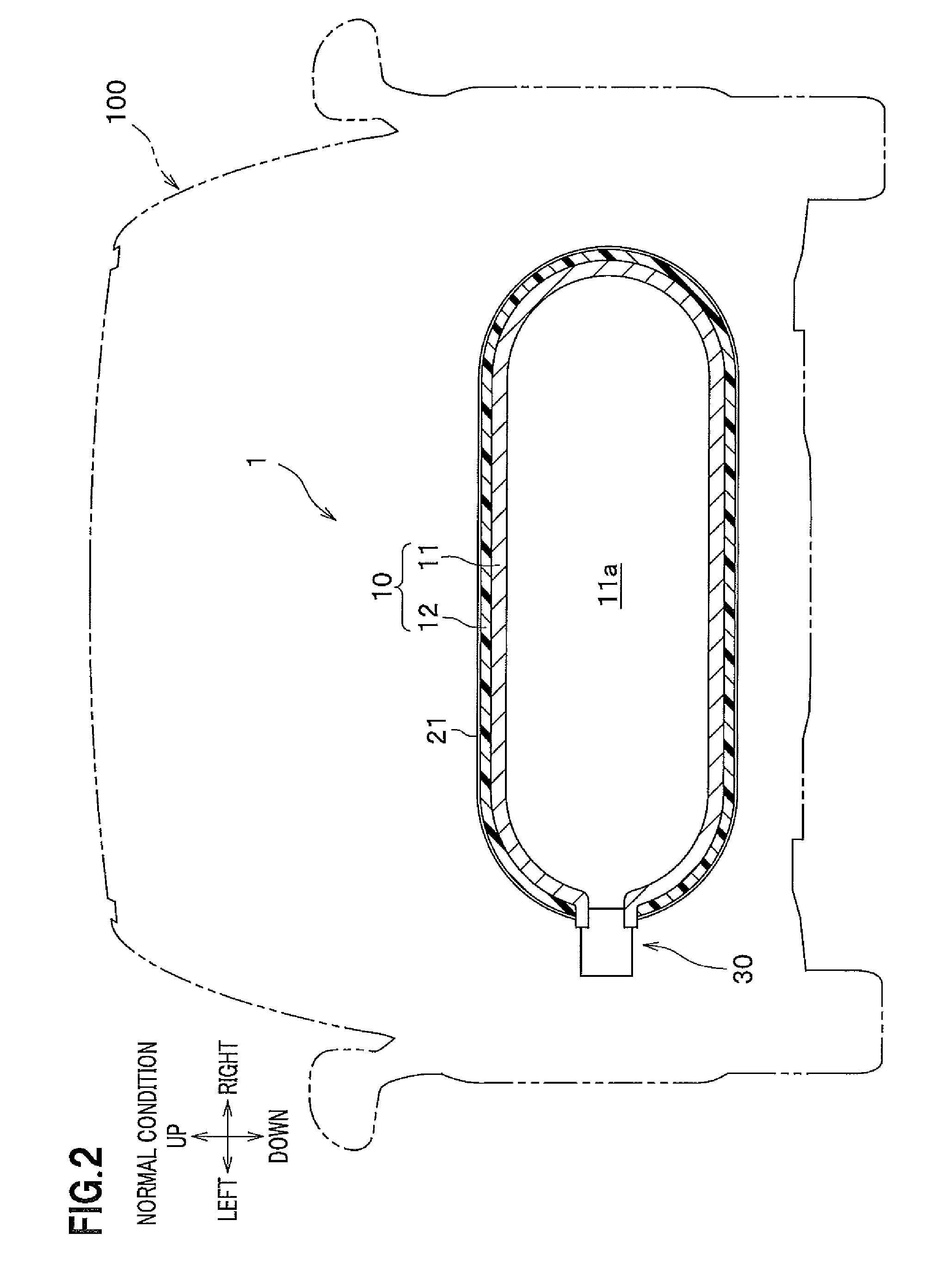Gas tank
a gas tank and gas pressure technology, applied in the field of gas tanks, can solve the problems of unlikely increase in gas pressure and unlikely increase in temperature of gas filled in the tank main body, and achieve the effect of suppressing the increase of gas pressur
- Summary
- Abstract
- Description
- Claims
- Application Information
AI Technical Summary
Benefits of technology
Problems solved by technology
Method used
Image
Examples
first embodiment
[0061]A first embodiment of the present invention will be explained with reference to FIGS. 1 to 6.
[0062]>
[0063]A fuel cell vehicle 100 (hereinafter, referred to as a travelling object) of this embodiment includes a fuel cell stack 110 (a fuel cell), a hydrogen tank 1 (a gas tank), a pressure-reduction valve 121, a compressor 131, and a dilution unit 132.
[0064]More specifically, the fuel cell vehicle 100 may be, for example, a four-wheel vehicle, a three-wheel cycle, a two-wheel vehicle, a unicycle, or a train.
[0065]The fuel cell stack 110 is a solid-polymer type fuel cell (Polymer Electrolyte Fuel Cell: PEFC), and has a plurality of stacked cells each including an MEA (Membrane Electrode Assembly) sandwiched between separators (not shown). The MEA has an electrolyte membrane (solid-polymer membrane), and a cathode and an anode sandwiching the MEA. Each separator is provided with an anode path 111 (a fuel gas path) and a cathode path 112 (an oxidant gas path) which are grooves or th...
second embodiment
[0113]Next, a second embodiment of the present invention will be explained with reference to FIG. 7. The only differences from the first embodiment will be given.
[0114]A hydrogen tank 2 of the second embodiment has, instead of the thermofoamable heat-insulating layer 21, a heat-insulating member 22 (a cover) which is fixed on the external surface 13 of the tank main body 10, and which initially has heat-insulating properties so as to serve a heat-insulating layer as it is. That is, it is unnecessary to apply a thermofoamable heat-insulating paint in order to form the thermofoamable heat-insulating layer 21, thus the hydrogen tank 2 can be simplified. Also, because the heat-insulating member 22 has a predetermined thickness, the hydrogen tank 2 hardly be deformed.
[0115]The heat-insulating member 22 comprises two vertically separated pieces, i.e., an upper half and a lower half, and is bonded, and fixed by using a bond or fastened and fixed by using a bolt, etc. . . . Also, the heat-i...
third embodiment
[0116]Next, a third embodiment of the present invention will be explained with reference to FIGS. 8 to 10. The only differences from the first embodiment will be given.
[0117]A hydrogen tank 3 of the third embodiment has, in addition to the configuration of the hydrogen tank 1 of the first embodiment, a bar-shaped heat pipe 51 (transferring component) arranged in the tank room 11a.
[0118]The left end of the heat pipe 51 is screwed to and fixed to the valve body 31 (see FIG. 9). That is, the heat pipe 51 is thermally coupled to the relief valve 30.
[0119]The heat pipe 51 extends from the relief valve 30 provided at the left end of the tank main body 10 toward the right end of the tank main body 10 in the tank room 11a (see FIG. 10). Also, a heat-insulating member 52 is provided on the surface of the heat pipe 51 other than the left end and the right end.
[0120]Accordingly, when heat is input from the right side of the hydrogen tank 3 into the tank room 11a, the heat is detected at the r...
PUM
 Login to View More
Login to View More Abstract
Description
Claims
Application Information
 Login to View More
Login to View More - R&D
- Intellectual Property
- Life Sciences
- Materials
- Tech Scout
- Unparalleled Data Quality
- Higher Quality Content
- 60% Fewer Hallucinations
Browse by: Latest US Patents, China's latest patents, Technical Efficacy Thesaurus, Application Domain, Technology Topic, Popular Technical Reports.
© 2025 PatSnap. All rights reserved.Legal|Privacy policy|Modern Slavery Act Transparency Statement|Sitemap|About US| Contact US: help@patsnap.com



